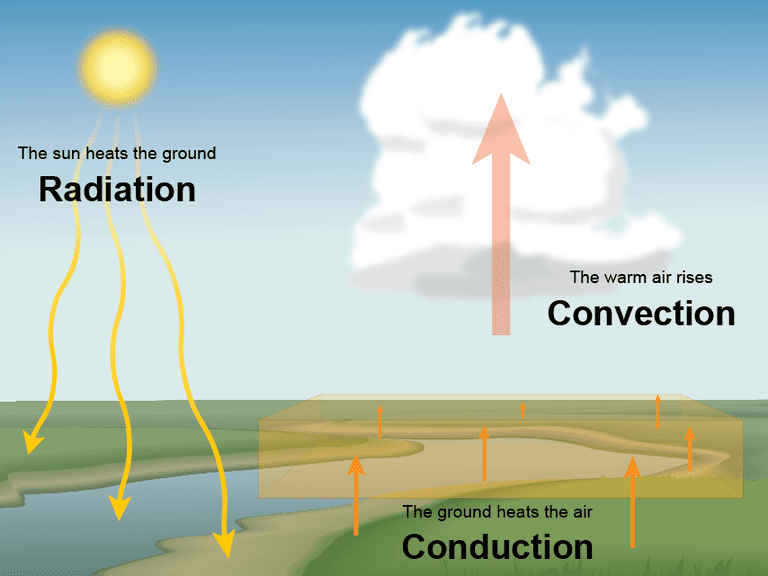Section 2: Atmosphere Energy Transfer
 Almost all of the energy in Earth’s atmosphere comes from the sun. Radiation is the energy transfer by electromagnetic waves that can travel through space. About 99% of radiant energy from the sun that reaches Earth is either visible light, infrared radiation, or ultraviolet light. Most sunlight is visible light in the form of a mixture of all the colors you see in the rainbow. Infrared radiation is a form of energy with wavelengths longer than visible light, and it is not visible but can be felt as heat. The sun also gives off ultraviolet light, which has short wavelengths and can break chemical bonds. As sunlight enters the atmosphere, it is converted to infrared radiation and is trapped by gases in the air called greenhouse gases. This is a natural process to regulate temperature on Earth, which is one of the most critical weather elements. These gases create a blanket around Earth called the greenhouse effect.
Almost all of the energy in Earth’s atmosphere comes from the sun. Radiation is the energy transfer by electromagnetic waves that can travel through space. About 99% of radiant energy from the sun that reaches Earth is either visible light, infrared radiation, or ultraviolet light. Most sunlight is visible light in the form of a mixture of all the colors you see in the rainbow. Infrared radiation is a form of energy with wavelengths longer than visible light, and it is not visible but can be felt as heat. The sun also gives off ultraviolet light, which has short wavelengths and can break chemical bonds. As sunlight enters the atmosphere, it is converted to infrared radiation and is trapped by gases in the air called greenhouse gases. This is a natural process to regulate temperature on Earth, which is one of the most critical weather elements. These gases create a blanket around Earth called the greenhouse effect.
 Three types of thermal energy transfer work together to heat the troposphere: radiation, conduction, and convection. Radiation is the direct transfer of energy by electromagnetic waves. Conduction is the transfer of thermal energy by contact particles of matter. It occurs when the atmosphere touches Earth. Convection transfers thermal energy by moving particles within matter and how air currents are heated. Finally, convection currents are formed when less dense air that is warmed by Earth’s surface is forced to rise by the downward movement of cooler, denser air.
Three types of thermal energy transfer work together to heat the troposphere: radiation, conduction, and convection. Radiation is the direct transfer of energy by electromagnetic waves. Conduction is the transfer of thermal energy by contact particles of matter. It occurs when the atmosphere touches Earth. Convection transfers thermal energy by moving particles within matter and how air currents are heated. Finally, convection currents are formed when less dense air that is warmed by Earth’s surface is forced to rise by the downward movement of cooler, denser air.
Stability refers to whether circulating air motions will be strong or weak. Stable conditions are caused by weak circulating air; unstable conditions are caused by strong moving air, usually producing thunderstorms. Temperature inversion occurs in the troposphere when the temperature increases as altitude increases. Trapped pollution can be the result of temperature inversion.
Review:
- Explain the characteristics of radiation.
- What is the Greenhouse Effect?
- What are the three types of energy transfer?
